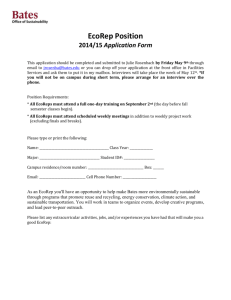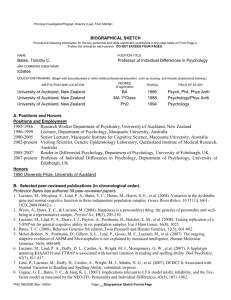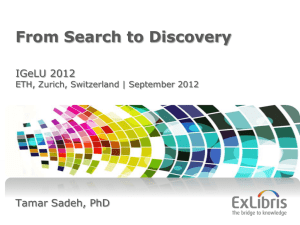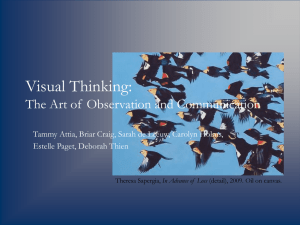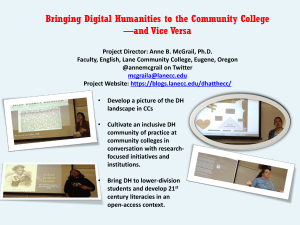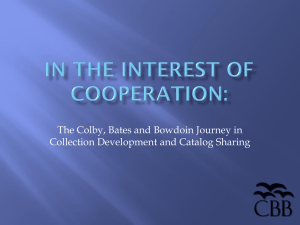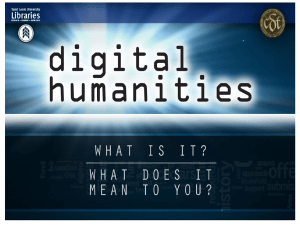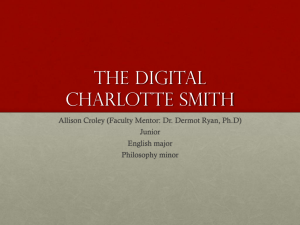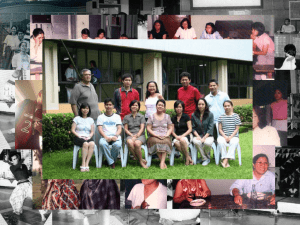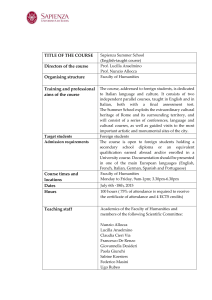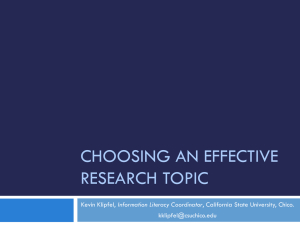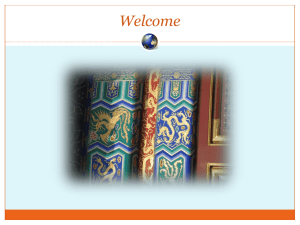Castles_and_Inverted... - The University of Arizona Campus
advertisement
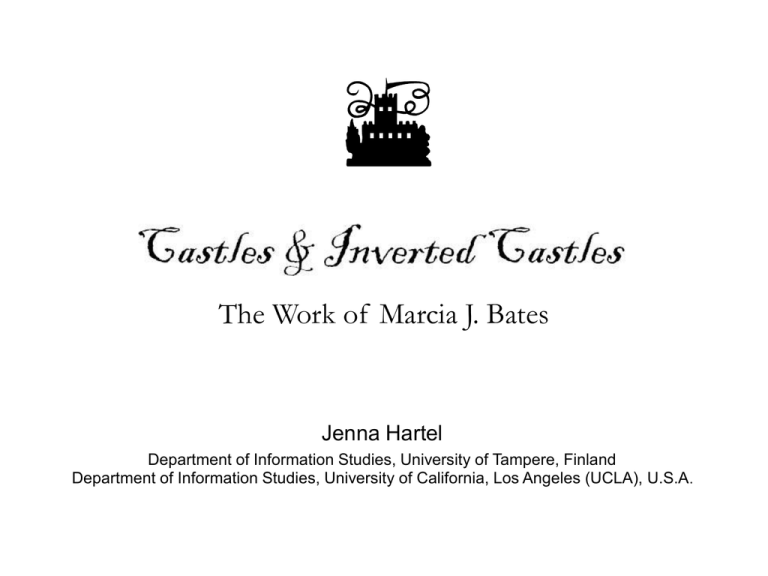
The Work of Marcia J. Bates Jenna Hartel Department of Information Studies, University of Tampere, Finland Department of Information Studies, University of California, Los Angeles (UCLA), U.S.A. White, H. D., & McCain, K. W. (1998). Visualizing a discipline: An author co-citation analysis of information science, 1972-1995. Journal of the American Society for Information Science, 49(4), 327-355. Bibliometrics Citation Analysis Science Communication Experimental Retrieval User Theory White, H. D., & McCain, K. W. (1998). Visualizing a discipline: An author co-citation analysis of information science, 1972-1995. Journal of the American Society for Information Science, 49(4), 327-355. Bibliometrics Science Communication Citation Analysis Experimental Retrieval User Theory “Scientist-Poets Wanted” by Howard D. White from The 50th Anniversary Special Issue of The Journal of the American Society for Information Science, guest edited by Marcia Bates Scientist-Poets Wanted: I see the field of library and information science (L&IS) highly centrifugal and greatly in need of high-quality syntheses. Library and information science has always been easy to enter by persons trained in other disciplines, particularly if they bring quantitative skills. The pattern has been many fresh starts by new entrants rather than strong cumulation. Nor is there full agreement as to which work is paradigmatic. Therefore, I would give warm encouragement to writers who show a talent for creative integration and criticism of ideas already embodied in the literature. Their efforts should indeed go into reading and organizing claims, rather than gathering new data. I would particularly like to see books that attempt to organize whole segments of L&IS through some single, powerful metaphor or thematic statement—for example, the notion of “information overload” notion of “cumulative advantage.” Since I think one of the scandals of the field is that there is no fat, standard textbook that we can all use and disparage, I would like to see ambitious people with backgrounds in literature or philosophy actually try to state what the canon is in L&IS— the writings that would be summarized in the textbook—and to justify their choices. If that is too Olympian, I would like critical explications of noted individual authors, such as Derek Price or Gerard Salton, by some-one who reads them in full and interviews their disciples and critics, in the manner of a journalist. I suppose I am calling for persons who add the skills of a poet to whatever training we can give them as scholars or scientists—scientist-poets, if you will. Why not try to recruit students with demonstrable skills writers into our Ph.D. programs and then ask them each to write a short book at the absolute top of their bent? Ask them to do for us what John McPhee has done for geology or Steven Pinker has done for linguistics. Would it be possible for use as models of academic writing not the usual dull dissertations but Howard Gard- The Mind’s New Science or Sherry Turkle’s The Second Self Tom McArthur’s Worlds of Reference? A talented newcomer might be asked into the problem of algorithmic synopsis writings as it has occurred from Hans Peter Luhn’s day to Henry Small’s; or the problem of getting concise word-association maps— Lauren Doyle’s “semantic roadmaps” of the early 1960s— onto the computer screen to help online searchers during an actual online search (instead of merely publishing them in journals). The latter is the now-fashionable problem of visualization of literatures, which Katherine McCain and I discussed in the 1997 ARIST. I call your attention to the fact that, just as we have no textbook, there has also never been a general account of our field published in the American trade press. There is no paperback you can give to your uncle at Christmas and say, “Here’s what it’s all about.” It would be nice to work toward such an account, perhaps by offering a monetary prize in an ASIS competition. Someday there might even be a section labeled Information Science, as there is one now for Linguistics, in bookstores like Borders or Dillon’s. Probably none of us will live that long, but one can dream. Howard D. White, College of Information Science and Technology, Drexel University A call to action for creative synthesis within LIS: I see the field of library and information science (L&IS) highly centrifugal and greatly in need of high-quality syntheses. …I would give warm encouragement to writers who show a talent for creative integration and criticism of ideas …I would particularly like to see books that attempt to organize whole segments of L&IS through some single, powerful metaphor … …I would like critical explications of noted individual authors…by some-one who reads them in full…… I am calling for persons who add the skills of a poet to whatever training we can give them as scholars or scientists — scientist-poets, if you will... Thesis Bates has created “castles” and “inverted castles” across the field of Library and Information Science, that clarify, structuralize, and popularize key notions about information. Bates Oeuvre Searching Information seeking behavior Information structure and organization General theoretical and professional issues of LIS Little known fact: She is synesthetic Synesthesia a neurologic condition in which a stimulus to one sense triggers another. Examples: a dog barking smells like lavender the color red sounds like fireworks ham tastes “pointy” Text is a locus for synesthesia. For synesthetes, letters and words may have personality and gender. The most common manifestation is a colored alphabet: abcdef ghijklm nopqrst uvwxyz Gershwin was a synesthete Nabokov was a synthesthete Kandinsky was a synesthete Does this impact Information Science? (Bates’ alphabet) Information Science ! Essentials of Bates’ Work • • • • • • • Crystallizes a situation or issue that afterwards seems obvious Provides structure to something previously unstructured Creates a simple model Uses vivid metaphors Has catchy terms or titles Integrative across specialties in LIS: structure -- use Integrative across scopes: theory -- practice Seven by Bates 1. Rigorous Systematic Bibliography (1976) 2. Search Tactics (1979) Information Search Tactics 3. What is a Reference Book? (1986) What is a Reference Book? A Theoretical and Empirical Analysis 4. Berrypicking (1989) The Design of Browsing and Berrypicking Techniques for the Online Search Interface 5. Getty/Humanities Reports (1993-1994) The Getty Online Searching Project Reports #1-5 6. Invisible Substrate (1999) The Invisible Substrate of Information Science 7. Cascade (2002) The Cascade of Interactions in the Digital Library Interface 1. Rigorous Systematic Bibliography (1976) Explains that any subject bibliography needs to be framed or is otherwise useless! Provides five guidelines for framing: scope, domain, information fields, organization, selection principles 2. Search Tactics (1979) Information Search Tactics PRESENTS 29 TACTICS FOR ONLINE SEARCHING! Search Tactic = a move made to further a search RESPELL: to try another spelling BIBBLE: to look for a bibliography already prepared CHECK, WEIGH, PATTERN, CORRECT, RECORD, SELECT, SURVEY, CUT, STRETCH, CLEAVE, SPECIFY, EXHAUST, REDUCE, PARALLEL, PINPOINT, NEIGHBOR, SCAFFOLD, BLOCK, SUPER, SUB, RELATE, TRACE, VARY, FIX, REARRANGE, RESPACE, CONTRARY This won the JASIS best paper for 1980 3. What is a Reference Book? (1986) What is a Reference Book? A Theoretical and Empirical Analysis Points out that there is no descriptive definition for “reference book.” Creates a definition based upon its unique structure: made up of files, records, and fields. Explains how structure encourages a certain manner of use: look up and scan not reading. 4. Berrypicking (1989) The Design of Browsing and Berrypicking Techniques for the Online Search Interface Key points: • Searching is an iterative behavior • Queries evolve during searching • Information is gathered a bit-at-a-time • Several types of resources and search techniques are used 5. Getty Humanities Studies (1993-1994) The Getty Online Searching Project Reports #1-5 An in-depth domain study of online search practices of humanities scholars using Dialog. Among other findings: • Humanities scholars relate differently to their literature than scientists. • Search terminology in the humanities is distinct. • Databases such as Dialog are poorly geared to humanities searching. Proposes concrete solutions to better serve humanities scholars. 6. Invisible Substrate (1999) The Invisible Substrate of Information Science Provides a succinct & inspiring definition of the information science field. Illuminates its unique emphasis on the structure and pattern of information. Locates LIS as a meta-discipline that runs orthogonal to subject disciplines. This won JASIS best paper for 1999! 7. Cascade (2002) The Cascade of Interactions in the Digital Library Interface • Models the elements that come together to form a digital library. • Shows how design features in one part of the system effect all other areas. Thesis Bates has created “castles” and “inverted castles” across the field of Library and Information Science, that clarify, structuralize, and popularize key notions about information. castles capture the imagination are architecturally fascinating and elaborate stand out on the landscape are memorable and enduring are seats of power soar to heights inverted castles are foundational & infrastructural (are built upon) create depth and stability are where the tools are stored, the workshops One way of viewing ideas in the IS field: (Glazier and Grover, 2002) paradigm grand theory formal theory substantive theory hypothesis research question proposition concept definition Castles & Inverted Castles paradigm Work in Progress grand theory formal theory Invisible Substrate substantive theory hypothesis Berrypicking research question Cascade Getty/Humanities proposition concept definition Search Tactics Rigorous Systematic Bibliography 1975 Reference Book? 1980 1985 1990 1995 2000 2005 NOT ALL SCHOLARS CREATE CASTLES As example: Shera’s work is more like a weather system Future Bates Marcia Bates has retired from full-time teaching at UCLA but is active in research and writing. She is working on a major meta-theoretical statement [ on information that is currently in review. ] The End Bibliography of Bates’ work reviewed: Bates, Marcia J. "Rigorous Systematic Bibliography." RQ 16 (Fall 1976): 7-26. Bates, Marcia J. "Information Search Tactics." Journal of the American Society for Information Science 30 (July 1979): 205-214. Bates, Marcia J. "What Is a Reference Book: A Theoretical and Empirical Analysis." RQ 26 (Fall 1986): 37-57. Bates, Marcia J. “The Design of Browsing and Berrypicking Techniques for the Online Search Interface.” Online Review 13 (October 1989): 407-424. Bates, Marcia J. “The Getty End-User Online Searching Project in the Humanities: Report No. 6: Overview and Conclusions.” College & Research Libraries 57 (November 1996): 514-523. Bates, Marcia J..”The Invisible Substrate of Information Science.” Journal of the American Society for Information Science 50, #12 (1999): 1043-1050. Bates, Marcia J. “The Cascade of Interactions in the Digital Library Interface. Information Processing and Management 38 (2002):381-400. Marcia Bates’ website: http://www.gseis.ucla.edu/faculty/bates/
